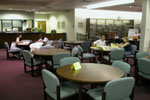Project Gutenberg.
Project Gutenberg. Before the controversial Google Books endeavor, the 40-year-old Project Gutenberg was the first effort to create an online digital library. Unlike Google Books, Project Gutenberg is scrupulous about verifying the copyright status of its works within US law before freely distributing these items. Dozens of titles are added weekly.
The collection is heavily weighted toward literature in English published before 1923, and thus in the public domain, though it has expanded into dozens of languages and several formats including audio books, recorded music, sheet music, still pictures, and video.
Project Gutenberg originally provided works in plain text only, but now has expanded into ePub, Kindle, and HTML formats that are compatible with smartphones and other portable reading devices, including Amazon's Kindle and Barnes and Noble's NOOK. Over 36,000 free e-books are available for downloading or online reading. Volunteers contribute their time to scanning and proofreading the texts.
The Gutenberg catalog is available as automatically generated MARC records for libraries to load directly into their online catalogs to link library users instantly to Gutenberg e-books. Several independently operated non-US affiliates with the same mission have been granted permission to use the Project Gutenberg trademark.
Between them, the Gutenberg group has placed over 100,000 e-books on the Web.
Many Internet efforts are well under way to build digital collections, including the aforementioned Google Books, the Universal Digital Library http://www.ulib.org/ , the Hathi Trust Digital Library http://catalog.hathitrust.org/ , the World Digital Library http://www.wdl.org/en/ , and the Internet Archive http://www.archive.org/ . With a collection of works that is perhaps less extensive than any of these, Project Gutenberg offers both a Web site and texts that are uniquely simple and usable. Summing Up: Essential. Lower- and upper-level undergraduates; general readers. -- M. Sylvia, St. Mary's University. Reviewed October, 2011 in ACRL's CHOICE.
The collection is heavily weighted toward literature in English published before 1923, and thus in the public domain, though it has expanded into dozens of languages and several formats including audio books, recorded music, sheet music, still pictures, and video.
Project Gutenberg originally provided works in plain text only, but now has expanded into ePub, Kindle, and HTML formats that are compatible with smartphones and other portable reading devices, including Amazon's Kindle and Barnes and Noble's NOOK. Over 36,000 free e-books are available for downloading or online reading. Volunteers contribute their time to scanning and proofreading the texts.
The Gutenberg catalog is available as automatically generated MARC records for libraries to load directly into their online catalogs to link library users instantly to Gutenberg e-books. Several independently operated non-US affiliates with the same mission have been granted permission to use the Project Gutenberg trademark.
Between them, the Gutenberg group has placed over 100,000 e-books on the Web.
Many Internet efforts are well under way to build digital collections, including the aforementioned Google Books, the Universal Digital Library http://www.ulib.org/ , the Hathi Trust Digital Library http://catalog.hathitrust.org/ , the World Digital Library http://www.wdl.org/en/ , and the Internet Archive http://www.archive.org/ . With a collection of works that is perhaps less extensive than any of these, Project Gutenberg offers both a Web site and texts that are uniquely simple and usable. Summing Up: Essential. Lower- and upper-level undergraduates; general readers. -- M. Sylvia, St. Mary's University. Reviewed October, 2011 in ACRL's CHOICE.







0 Comments:
Post a Comment
<< Home